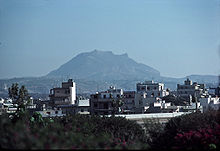- Mount Juktas
-
A mountain in north-central Crete, Mount Juktas (also spelled Iuktas, Iouktas, and a variety of others due to irregular transliteration from Greek) was an important religious site for the Minoan Civilization.[1] Located a few kilometers from the palaces of Knossos and Fourni and the "megaron" at Vathypetro, Mount Juktas was the site of an important peak sanctuary in the Minoan world. At the base of Juktas, at Anemospilia was also found a site that suggested to some that the Minoans practiced human sacrifice, but the evidence is currently somewhat in question.
Contents
Peak Sanctuary
Mount Juktas is the site of one of the most important peak sanctuaries in the Minoan world. It is also probably the first of the peak sanctuaries. Archaeologists have studied the site over an extensive period, examining fragments of pottery, remains of walls, and some unique kinds of stone that must have been hauled up the mountain because they do not occur atop the mountain.
The mountain remains important in the religious life of the people of the area up to this day - a Greek Orthodox chapel is located about a kilometer south of the sanctuary along the ridge of the mountain. Every year, people from towns down in the plains below Mount Juktas bring flowers in procession to the chapel.
Archaeology
Juktas was first excavated in 1909 by Sir Arthur Evans.
Jutkas can be regarded as an adjunct archaeological site to the important Knossos site a few kilometres distant.[2] Among the finds at the Juktas Minoan peak sanctuary were clay human and animal figurines, stone horns, stone altars, bronze double axes, and both bowls and tables with Linear A inscriptions. See references for a more comprehensive inventory. Pottery sherds from the site date back as far as Middle Minoan IA.
References
- Anna Simandiraki, Middle Minoan III Pottery from Building B of the Peak Sancturay of Mount Juktas, Crete, and a general re-assessment of the Middle Minoan III Period, PhD Thesis, University of Bristol, 2002, British Library catalogue
- C. Michael Hogan (2007) Knossos fieldnotes, The Modern Antiquarian
- Donald W. Jones (1999) Peak Sanctuaries and Sacred Caves in Minoan Crete ISBN 91-7081-153-9
Line notes
External links
Categories:- Heraklion Prefecture
- Minoan civilization
- Mountains of Crete
- Geography of ancient Crete
- European archaeology stubs
- Crete geography stubs
Wikimedia Foundation. 2010.

